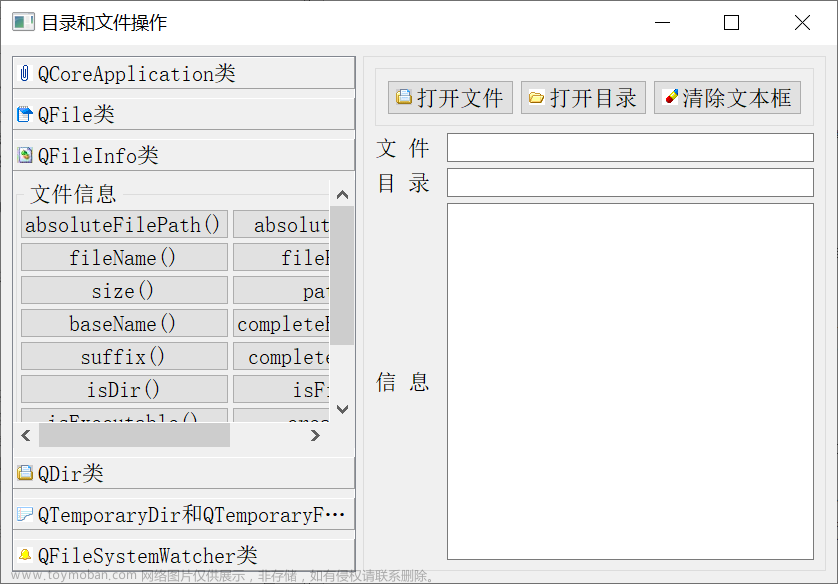目录
1.读csv文件
2.写入csv文件
3.向csv文件中追加内容
4.具体使用
4.1读入csv文件
4.2写入csv文件
4.3向csv文件追加
内容参考
使用说明:csv文件按照","进行分隔。因此每个内容中需避免出现","
1.读csv文件
c++通过文件读入方式打开文件。即通过ifstream类进行打开文件。
string fname = "test.csv";
//以读入方式打开文件
ifstream csv_data(fname, ios::in);
if (!csv_data.is_open())
{
cout << "Error: opening file fail" << endl;
exit(1);
}
else {
string line;
vector<string> words; //声明一个字符串向量
string word;
// ------------读取数据-----------------
// 读取标题行
getline(csv_data, line);
istringstream sin;
// 按行读取数据
while (getline(csv_data, line))
{
// 清空vector及字符串流,只存当前行的数据
words.clear();
sin.clear();
sin.str(line);
//将字符串流sin中的字符读到字符串数组words中,以逗号为分隔符
while (getline(sin, word, ','))
{
cout << word << endl;
words.push_back(word); //将每一格中的数据逐个push
}
}
csv_data.close();
}
2.写入csv文件
c++通过文件写入方式打开文件进行写入。即通过ofstream类进行写入,并在打开文件中指明ios::out。
说明:默认通过iso::out方式进行写入,当文件不存在时会进行创建
string fname = "test.csv";
ofstream outFile(fname, ios::out);
// 写入标题行
outFile << "name" << ','
<< "income" << ','
<< "expenditure" << ','
<< "addr" << endl;
// ********写入两行数据*********
outFile << "zhangsan" << ','
<< "3000" << ','
<< "1200" << ','
<< "陕西省" << endl;
outFile << "lisi" << ','
<< to_string(2032.1) << ','
<< to_string(789.2) << ','
<< "北京市" << endl;
//数字需转为字符串进行写入,csv文件结束一行写入需要"\n"或者endl进行换行
outFile.close();3.向csv文件中追加内容
与第2部分几乎相同,只不过是打开文件时选择ios::app方式进行。当文件不存在时会进行创建
ofstream outFile(fname, ios::app);
// ********写入两行数据*********
outFile << "wangwu" << ','
<< "1234" << ','
<< to_string(12.32) << ','
<< "河南省" << endl;
outFile << "lisi" << ','
<< to_string(2032.1) << ','
<< to_string(789.2) << ','
<< "北京市" << endl;
//数字需转为字符串进行写入,csv文件结束一行写入需要"\n"或者endl进行换行
outFile.close();4.具体使用
4.1读入csv文件
#include <iostream>
#include <fstream>
#include <sstream>
#include <vector>
#include <string>
using namespace std;
void PrintCSVLine(vector<string> line_data)
{
//此语法仅在C++11中适用
for (string str : line_data)
{
cout << str << " ";
}
cout << endl;
}
//读入csv文件
int main() {
string fname = "test.csv";
//以读入方式打开文件
ifstream csv_data(fname, ios::in);
if (!csv_data.is_open())
{
cout << "Error: opening file fail" << endl;
exit(1);
}
else {
string line;
vector<string> words; //声明一个字符串向量
string word;
// ------------读取数据-----------------
// 读取标题行
getline(csv_data, line);
istringstream sin;
// 按行读取数据
while (getline(csv_data, line))
{
// 清空vector及字符串流,只存当前行的数据
words.clear();
sin.clear();
sin.str(line);
//将字符串流sin中的字符读到字符串数组words中,以逗号为分隔符
while (getline(sin, word, ','))
{
//cout << word << endl;
words.push_back(word); //将每一格中的数据逐个push
}
//输出此行中的内容
PrintCSVLine(words);
}
csv_data.close();
}
}4.2写入csv文件
#include <iostream>
#include <fstream>
#include <string>
using namespace std;
int main()
{
string fname = "test.csv";
ofstream outFile(fname, ios::out);
if (outFile.is_open()) // 检查文件是否打开成功
{
// 写入标题行
outFile << "name" << ','
<< "income" << ','
<< "expenditure" << ','
<< "addr" << endl;
// ********写入两行数据*********
outFile << "zhangsan" << ','
<< "3000" << ','
<< "1200" << ','
<< "陕西省" << endl;
outFile << "lisi" << ','
<< to_string(2032.1) << ','
<< to_string(789.2) << ','
<< "北京市" << endl;
//数字需转为字符串进行写入,csv文件结束一行写入需要"\n"或者endl进行换行
outFile.close();
}
else
{
cout << "文件无法打开!" << endl;
}
}
4.3向csv文件追加
#include <iostream>
#include <fstream>
#include <string>
using namespace std;
int main()
{
string fname = "test.csv";
//先判断文件是否存在
ifstream file(fname);
if (!file.is_open()) {
cout << "File does not exist!" << endl;
return 1;
}
else {
cout << "File exists!" << endl;
file.close();//必须先关闭文件后才可写入
ofstream outFile(fname, ios::app);
// ********写入两行数据*********
outFile << "wangwu" << ','
<< "1234" << ','
<< to_string(12.32) << ','
<< "河南省" << endl;
outFile << "lisi" << ','
<< to_string(2032.1) << ','
<< to_string(789.2) << ','
<< "北京市" << endl;
//数字需转为字符串进行写入,csv文件结束一行写入需要"\n"或者endl进行换行
outFile.close();
}
return 0;
}
内容参考
C++读写CSV文件_c++读取csv文件_灰灰2号的博客-CSDN博客文章来源:https://www.toymoban.com/news/detail-603769.html
若发现此文章存在不足/缺陷/BUG,请联系作者修改文章来源地址https://www.toymoban.com/news/detail-603769.html
到了这里,关于C++对csv文件操作(读、写、追加)的文章就介绍完了。如果您还想了解更多内容,请在右上角搜索TOY模板网以前的文章或继续浏览下面的相关文章,希望大家以后多多支持TOY模板网!










